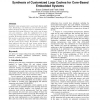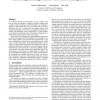213 search results - page 9 / 43 » Introducing Product Lines in Small Embedded Systems |
HIPEAC
2010
Springer
13 years 5 months ago
2010
Springer
We propose a new design for an energy-efficient hardware transactional memory (HTM) system for power-aware embedded devices. Prior hardware transactional memory designs proposed a ...
ICCAD
2002
IEEE
14 years 4 months ago
2002
IEEE
Embedded system programs tend to spend much time in small loops. Introducing a very small loop cache into the instruction memory hierarchy has thus been shown to substantially red...
SIGSOFT
2005
ACM
14 years 1 months ago
2005
ACM
Reuse has always been a major goal in software engineering, since it promises large gains in productivity, quality and time to market reduction. Practical experience has shown tha...
DATE
2002
IEEE
14 years 15 days ago
2002
IEEE
In this paper, we analyze the use of UML as a starting point to go from design issues to end of production testing of complex embedded systems. The first point is the analysis of ...
AOSD
2008
ACM
13 years 9 months ago
2008
ACM
In a software product line, the binding time of a feature is the time at which one decides to include or exclude a feature from a product. Typical binding site implementations are...


